Click here to learn more ADHD Greenville
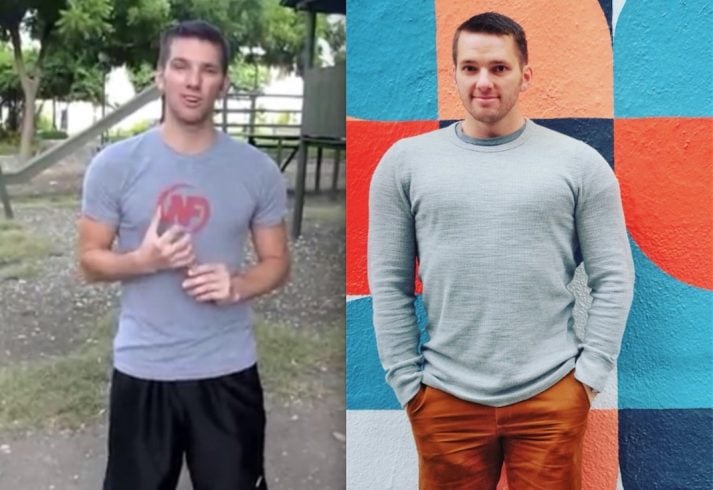
So you want to gain weight fast (and safely)?
You’ve come to the right place, because this is what we do!
This guide covers the exact weight gain strategies I’ve used to go from my “before” (on the left above) to reach my “after” (on the right above). Believe it or not, that “before” photo is me after a DECADE of strength training and trying to get bigger.
It’s the stuff in this guide that finally allowed me to actually get results (the after).
It’s also exactly how we help our online coaching clients: nutritional guidance and workout plans that line up with their goals.
Oh, and if you sign up in any of the yellow email boxes throughout, you can download our “gain weight and build muscle” shopping list and cheat sheet to hang on your fridge!
- The Nerd Fitness "Get Bigger" Shopping List
- Bulk like the Hulk with our rules for getting bigger
Let’s start putting on weight right NOW.
These are the 12 lessons I wish I knew when I started trying to get bigger (click to jump right to that lesson):
NUTRITION
- How to eat to gain weight.
- What foods should I eat to gain weight?
- How much protein do I need to gain weight?
- How many carbs and fats should I eat to gain weight?
- How fast can I gain weight and get bigger?
STRENGTH TRAINING
- What exercises are best for weight gain?
- How to get stronger and build muscle.
- How many days should I exercise to gain weight?
RECOVERY
- How much sleep should I get to gain weight?
- Should I do cardio while trying to gain weight?
- Can you build muscle without gaining fat?
- Gain weight, get bigger and supercharge your results.
Rule #1) How to eat to gain weight.

As we cover in our “Ultimate Skinny Guy’s Guide to Bulking Up Fast,” there’s one rule you need to know above EVERYTHING else.
“If you’re not gaining weight, you’re not eating enough food.”
It’s science and thermodynamics.
Allow me to explain: Depending on your current size and level of activity, your body burns 1200-2500+ calories every day just doing all of its daily processes:
- Breathing.
- Keeping your heart beating.
- Powering your liver, kidneys, and brain.
- Powering your movement.
- Rebuilding muscle.
- And dozens of other things.
Because your body efficiently uses up all of the calories you consume every day, there are no calories left over to build muscle or get stored as fat.
Want to know how many calories you burn every day? Check out our Total Daily Energy Expenditure TDEE calculator:
Use the metric system? I wish we did too here in the States! Click right here for our Metric calculator.
Note: we have used The Mifflin-St Jeor Equation to create this calculator! [1]
Hooray! You now know estimates of your Basal Metabolic Rate (calories you burn existing) and TDEE (calories you burn while moving throughout the day)![2]
So, in order to get bigger, you need to eat ABOVE this TDEE number consistently.
That’s it.

This is the NUMBER ONE mistake skinny people make trying to get bigger:
We think we have an an overly fast metabolism.
Although there is SOME variation with regards to metabolism variability, it’s insignificant when compared to the effect of the more important part of the equation:
We overestimate how many calories we’re eating each day, we don’t account for the calories we burn through movement or exercise, and there aren’t enough calories left over to create a “caloric surplus.”
And without that surplus, we’ll never gain weight or get bigger.

MY STORY: I had been training in a gym for 6 years and not getting bigger.
I then worked with a great trainer, who had me DOUBLE the amount of food I was eating.
I thought he was out of his mind.
Until I did it and it worked.
I put on 18 pounds in 30 days [3], and I realized I had been severely undereating for my goals:
In order to gain weight, target an additional 300-500 calories above your Total Daily Energy Expenditure[4]:
- If you have a TDEE of 1800 calories: target 2100-2300 calories per day to gain a pound a week (0.5 kg per week).
- If you have a TDEE of 2000 calories: target 2300-2500 calories per day to gain a pound a week (0.5 kg per week).
Want to gain weight even faster? As long as you know you’ll also be gaining lots of fat, you can target 800-1000 calories above your TDEE.
- If you have a TDEE of 1800 calories: target 2600-2800 calories per day to gain 2 lbs a week (1 kg per week).
- If you have a TDEE of 2000 calories: target 2800-3000 calories per day to gain 2 lbs. a week (1 kg per week).
What about meal timing? Does it matter WHEN I eat my meals?
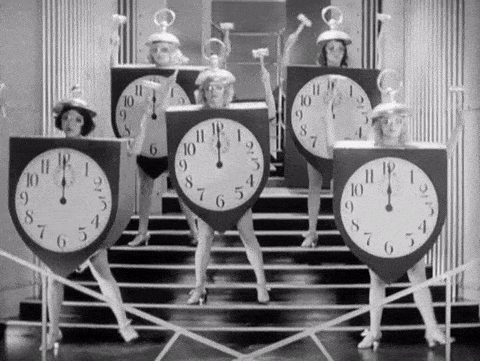
WHEN you eat doesn’t matter nearly as much as HOW MUCH you eat.
Your body will process all calories efficiently[5], so focus on total calories consumed.
Depending on your schedule you can:
- Eat 3 big meals for breakfast lunch and dinner.
- Eat 6 regular sized meals throughout the day.
- Skip breakfast and eat two MONSTER meals (this is what I do).
It comes down to your personal preference. You might struggle to eat 3000 calories in 3 meals, so having 6 500-calorie meals throughout the day might make you feel less bloated and full.
Your value may vary!
See the next section for tips and tricks on WHAT foods you should eat to gain weight.
If you want somebody to help keep you accountable and help you actually bulk up safely and quickly, we have a pretty great online coaching program that has helped people reach their weight gain goals safely and quickly.
Rule #2) What foods should I eat to gain weight?
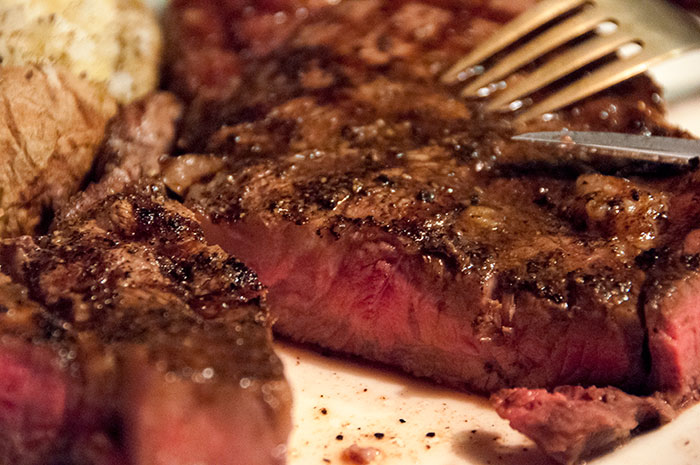
If you want to build muscle, target whole foods that come from high quality, high-calorie sources whenever possible.
Sure, you could obtain 3500 calories eating Taco Bell, Twinkies, candy and Mountain Dew, but this isn’t a good long term solution to gaining weight and building a good physique (goodbye health).
Trust me, I know. I put on 18 pounds in 30 days by eating meatball subs from Subway, drinking whole milk, eating McDonald’s, and drinking weight gainer shakes.
I certainly wasn’t healthy, and today I’m much more intelligent and knowledgeable about how to bulk up safely.
The most important macro we’re going to focus on is protein[6], as studies have shown you’re more likely to put on the right kind of weight with a high protein diet compared to a low protein diet, and that’s where we’ll start:
HERE’S HOW TO EAT TO GAIN WEIGHT:
- Calculate your (Total daily energy expenditure) and add 300-500 cal over your number for sustainable weight gain.
- Consume at least 1-1.5g per pound (2.2-3.3g per kg) of bodyweight in protein daily.
- Consume .25-.4g per pound (.5-.8g per kg) of bodyweight in fat daily.
- Consume the rest of your calorie goals from healthy carbs.
- Eat vegetables so that your body can process all the extra food.
- If you are not gaining weight, add more carbs and/or fats to your meal.
We’re going to start building a healthy plate. Your goal should be to eat as much as you need to create your caloric surplus.
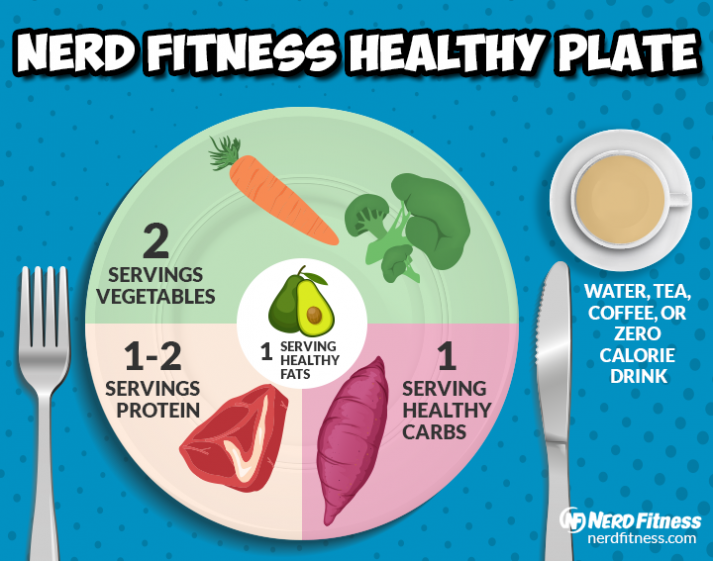
FOOD PRIORITY #1: PROTEIN
Protein can come from any number of sources, including:
- Meat (steak, bison, pork).
- Fowl (chicken, turkey, duck).
- Eggs![7]
- Cheese and dairy.
- Fish and shellfish (salmon, tuna, shrimp).
- Legumes (black beans, chickpeas).
- Other vegetarian protein sources here.
If you’re curious, from our healthy eating article, this is what a portion of protein looks like:
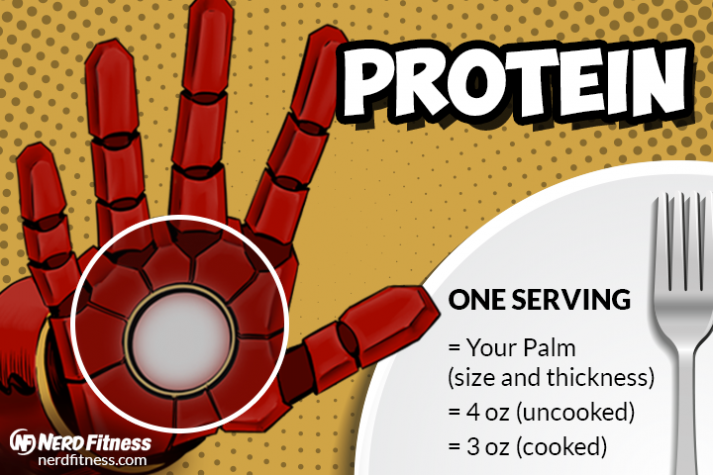
Also, here’s how much protein is in a serving of food:
- 4 oz (113 g) of chicken has around 30 g of protein.
- 4 oz (113 g) of salmon has 23 g of protein
- 4 oz (113 g) of steak has 28 g of protein.
As we’ll cover below and in our “How much protein should I eat?” guide, target 1-1.5g per lb (2.2-3.3g per kg) of bodyweight.
PRIORITY #2: CARBS
In order for you to gain weight, you need to consume enough calories, so the remainder of those calories will come from carbs and/or fats.
Here are whole foods full of carbohydrates:
- Rice
- Quinoa
- Oats
- Legumes and lentils
- Sweet potatoes
- Yams
- Regular potatoes
- Whole grain pasta
- Whole grain bread
To help you get better at eyeballing serving sizes:
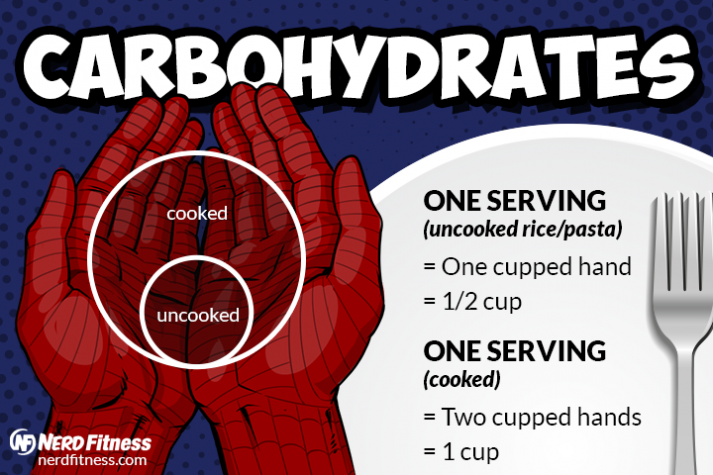
1 serving of a starchy carbohydrate is 1 cupped hand (uncooked), or your two hands forming a cup (cooked).
Here are some images to help you learn proper portion sizes (thanks to SafeFood):
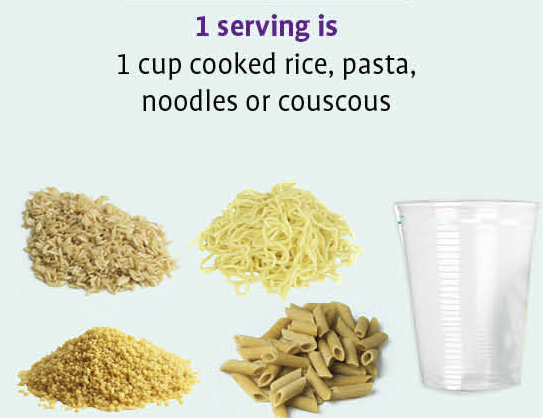
In addition to consuming carbohydrates from these sources, it’s okay to consume plenty of fruit while trying to bulk up!
You can read our full “Is fruit healthy” guide to learn more.
PRIORITY #3: FAT!
Fat is a macronutrient that you can eat to help reach your goals, as fat can be higher in calories, plus you can eat lots of it without feeling full.
Healthy fat can be found in foods like:
- Avocado
- Almonds
- Walnuts
- Macadamia nuts
- Olive oil
- Almond butter
- Peanut butter
Saturated fats[8] can come from things like:
- Whole milk
- Full fat dairy
- Coconut oil
- Grass-fed butter
- Fatty cuts of meat
- Lard
To help you gauge: a serving size of fat is roughly the size of your thumb!
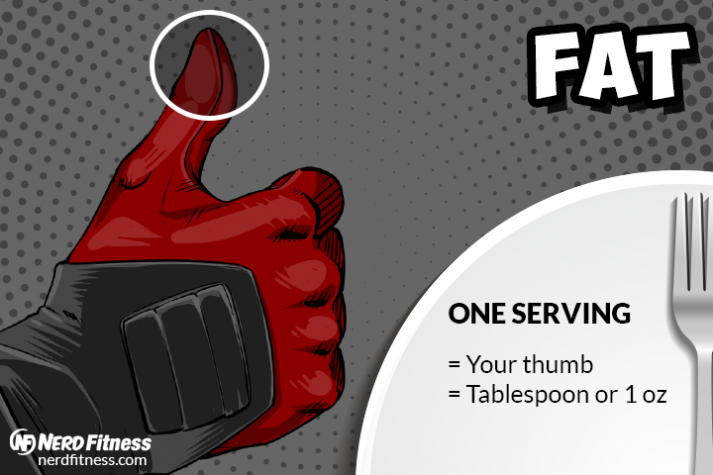
For reference, this is a single serving of almonds (162 calories):

THIS is a serving of olive oil (60 calories):

As you can see, you can eat an extra 500 calories of “healthy fats” by eating lots of “heart-healthy” fats like nuts or adding more olive oil to your meals.
PRIORITY #4: VEGETABLES!
Last but not least, you need vegetables in your diet.
If you start to eat a lot more food, your “indoor plumbing” is going to really benefit from eating some high-fiber veggies with each meal:
A serving of veggies is about the size of your fist:
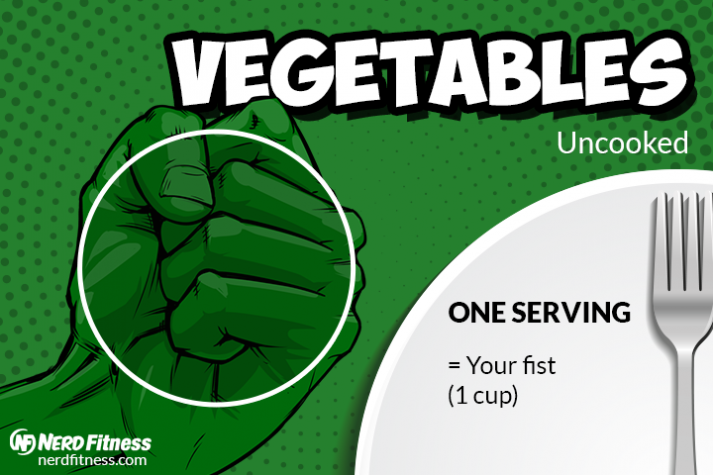
Here’s a quick, non-complete list of veggies that you can choose:
- Broccoli
- Broccolini
- Cauliflower
- Spinach
- Kale
- Spaghetti squash
- Brussels sprouts
- Zucchini
- Cucumber
- Carrots
- Onion
- Asparagus
“BUT STEVE, I REALLY STRUGGLE TO EAT ENOUGH CALORIES FROM WHOLE FOODS EVERY DAY!“
I do too. It’s why I consume a good portion of liquid calories every day too.

It’s a surefire way to make sure you hit your calorie goals.
As I lay out in our massive Protein Shake Guide, creating high calorie protein shakes to eat between meals can be the game changer (make sure you check the recipe in that article for my “Powerbomb Shake!”).
Also, download our Skinny Guy Guide which has both lessons and a shopping list you can use to prioritize eating the right high calorie, high quality foods!
- The Nerd Fitness "Get Bigger" Shopping List
- Bulk like the Hulk with our rules for getting bigger
Rule #3) How MUch Protein to Eat to Gain Weight?
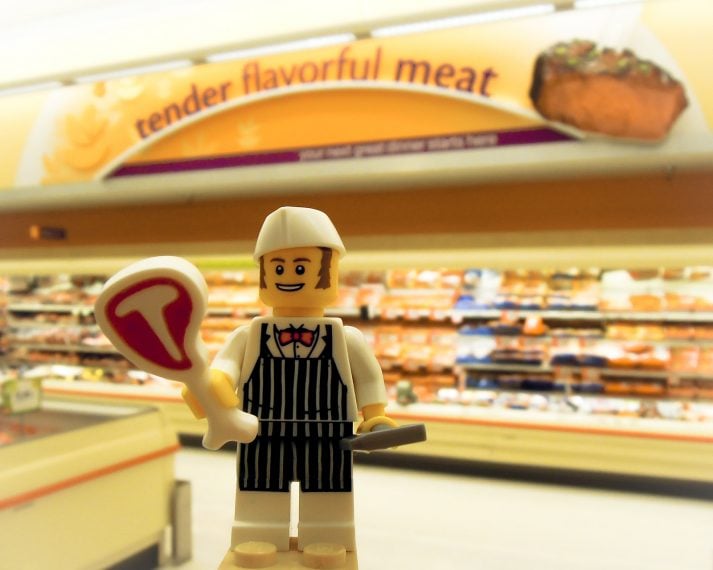
As we cover above, you can get your protein from any number of sources:
- Meat (steak, bison, pork).
- Fowl (chicken, turkey, duck).
- Eggs![9]
- Cheese and dairy.
- Fish and shellfish (salmon, tuna, shrimp).
- Legumes (black beans, chickpeas).
- Protein supplements like whey, casein, pea, etc.
- Other vegetarian protein sources here.
So next let’s answer the question: “How much protein do you need every day?”
The current international Recommended Dietary Allowance (RDA) for protein is 0.4g per pound of bodyweight (0.8 g per kg of body weight):[10].
In our opinion, and as pointed out by this study[11] the RDA # for protein is too low and should be higher regardless of your body composition.
But you don’t care about that. You just want me to tell you how much protein to eat, right?

I figured.
Here is our recommendation[12]:
If you’re of healthy weight, active, and wish to build muscle, aim for 1 g/lb (2.2 g/kg).
If you’re going to be strength training while getting bigger, intakes up to 1.50 g/lb (3.3 g/kg) may help you minimize fat gain.[13]
Let me simplify it for you: target at least 1 gram of protein per pound of bodyweight (2.2 grams per kg).
Provided you’re a healthy individual with a healthy liver, you don’t need to worry about eating too much protein[14] – you should be more concerned with eating too little protein.
Long story short: studies suggest you will not put on the right kind of weight without consuming enough protein!
Okay, so let’s talk portions. Here’s how much protein is in a palm-sized serving of food:
- 4 oz (113 g) of chicken has around 30 g of protein.
- 4 oz (113 g) of salmon has 23 g of protein
- 4 oz (113 g) of steak has 28 g of protein.
EXAMPLE TIME!

Let’s say you weigh 150 pounds (68 kg).
That would mean a day of eating could be:
- 1 serving of protein with breakfast (30g protein shake).
- 2 servings of protein with lunch: 2 chicken breasts (60g).
- 2 servings of protein with dinner: 2 portions of steak (56g).
As we cover in our Ultimate Guide to Protein Shakes, a protein supplement can help you reach your protein goals for the day.
Creating a high-calorie protein shake with foods like frozen fruit, oats, milk, and a scoop of protein can be huge.
It’s how I hit my goals every day!
MY STORY: I am currently bulking up, and according to my online coach, I need to eat 3200 calories with 240g of protein on workout days (I weigh 172 pounds).
After fasting until noon, here’s how I get 240 g of protein daily:
- LUNCH: Double chicken bowl at Chipotle for lunch (rice, chicken, guac, lettuce, cheese): 77g of protein.
- SNACK: 2 servings Optimum Nutrition Whey in my powerbomb shake: 70g of protein.
- DINNER: 8 oz of grilled chicken, 2 servings of rice, lots of broccoli: 62 g of protein.
- SNACK: 1 serving Optimum Nutrition Whey in my 1/2 powerbomb shake. 35g of protein.
Total protein intake for me: 244 grams. Adjust to fit YOUR goals!
RECAP ON PROTEIN INTAKE: Target 1-1.5g per lb of bodyweight (2.2-3.3g per kg) while trying to gain weight. When in doubt, eat more.
Rule #4) How Much Carbs and Fats Should I Eat to Gain Weight?

If you are trying to put on a lot of weight, carbs and fats are your friends.
They have a high-calorie count and you can eat lots of them without getting as full as some other things (like protein).
Here are foods full of carbohydrates you can prioritize for bulking up:
- Rice
- Quinoa
- Oats
- Legumes and lentils
- Sweet potatoes
- Yams
- Regular potatoes
- Whole grain pasta
- Whole grain bread
Healthy fat can be found in foods like:
- Avocado
- Almonds
- Walnuts
- Macadamia nuts
- Olive oil
- Almond butter
- Peanut butter
- Whole milk
- Full fat dairy
- Coconut oil
- Grass-fed butter
- Fatty cuts of meat
- Lard
Once you know your Total Daily Energy Expenditure + 500 cal (for weight gain), and you know how many grams of protein you need to eat every day, then the remainder of your daily calories can come from carbs and fats.
Want even simpler info? Target 2 portions of carbs, and 2 portions of fat in your meals. If you’re not gaining weight, increase those numbers even more.
This is all about math! Not getting bigger = need MOAR food.

What about other foods like pizza, pasta, candy soda? Sure, you can get away with consuming less healthy things ON OCCASION (pizza, subs, etc.) but avoid fueling yourself with ONLY junk food.
If you’re not sure specifically what you should be eating for protein, carbs, and fats, download our “Get Bigger” Shopping List by putting your email in the box below:
- The Nerd Fitness "Get Bigger" Shopping List
- Bulk like the Hulk with our rules for getting bigger
Rule #5) How Fast Can I gain Weight?

Depending on your training, genetics, how skinny you are, and how much muscle you need to obtain, you can decide how much weight you want to gain each week.
Everybody’s results will vary, and thoughts are mixed on how quickly we can build muscle:
- Under optimal conditions, some say you can expect to gain 1 pound (.5 kg) of muscle per week,
- My results have shown that 2 lbs (1kg) per month is more realistic.
- A 2016 study[15]revealed that strength training produced a 2.2 lb increase (1kg) increase in lean mass in 8 weeks.
Now, depending on how thin you are currently, you might WANT to gain weight even faster and put on a bit of fat.
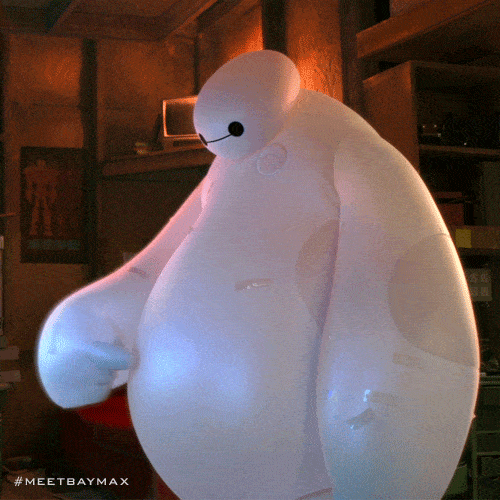
If you target 500 calories above your Calorie Expenditure every day, you’ll gain a pound a week.
- If you have a TDEE of 1800 calories: target 2100-2300 calories per day to gain a pound a week (0.5 kg per week).
- If you have a TDEE of 2000 calories: target 2300-2500 calories per day to gain a pound a week (0.5 kg per week).
If you target 1000 calories above your TDEE, you’ll gain 2 pounds per week:
- If you have a TDEE of 1800 calories: target 2600-2800 calories per day to gain 2 lbs a week (1 kg per week).
- If you have a TDEE of 2000 calories: target 2800-3000 calories per day to gain 2 lbs. a week (1 kg per week).
Yes, it is possible to put on even more weight than that in a short amount of time, like when I gained 18 pounds (8.1kg) in 30 days.
This was due to consuming 1500 cal above my TDEE, heavy barbell training, targeting lots of protein, and carrying extra water weight (from supplementing with creatine):
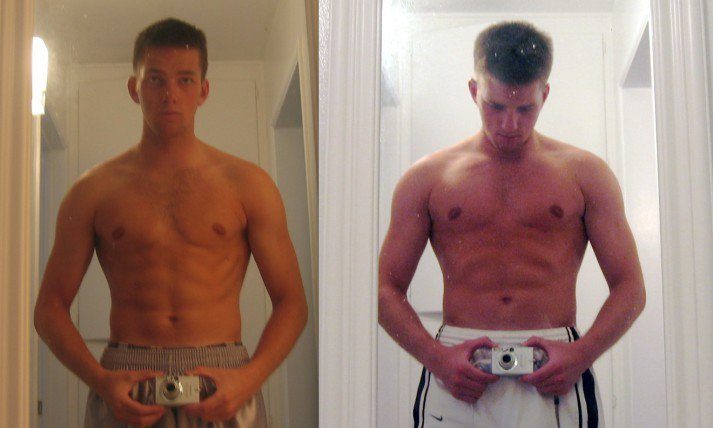
My advice: Rather than chasing massive weight gain over a month, you’d be much better off gaining .5-1.5 lbs. (.25-.75 kg) a week, every week, for six months…and keeping the weight on!
So, how do you know if your efforts are working? Simple.
Taking measurements, take photos, and weigh yourself daily:
- Take front and side photos every Monday.
- Track your meals every day.
- Weigh yourself every other day.
If the scale is moving UP, keep doing what you’re doing.
If the scale is NOT moving: EAT MORE.
If you’re ever unsure if you’ve eaten enough that day, eat more.
Once you start to get a good feel for how many calories you eat each day, try to eat the same meals to keep it easy.
Still convinced you can’t gain weight even after tracking things? Let us help. I too was convinced that it was my “fast metabolism,” until I learned from my personal trainer that I simply wasn’t eating enough.
Rule #6) What Are the 10 Best Exercises For Weight Gain?

Up until this point, we’ve only talked about the weight gain portion.
Do Steps 1-5 above, and you’ll put on plenty of weight.
HOWEVER, if you’re not also training correctly, you’ll just be getting fat, and not building muscle!

That’s where strength training comes in!
If you want to bulk up correctly, you need to be strength training with heavy weight and bodyweight movements.
As we lay out in our “Beginner Strength Workouts” guide, these are the BEST exercises you can do to gain weight:


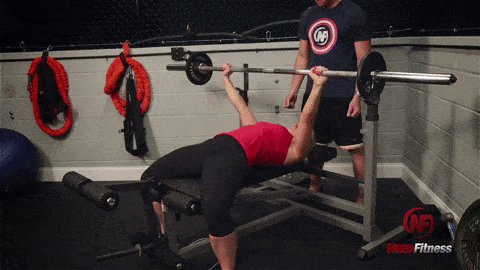
- INCLINE BENCH PRESS:
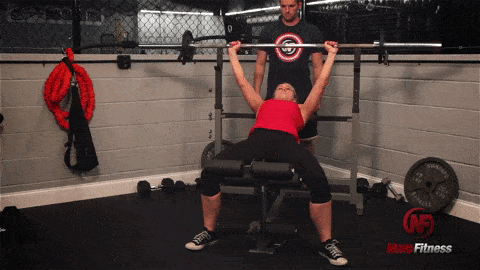

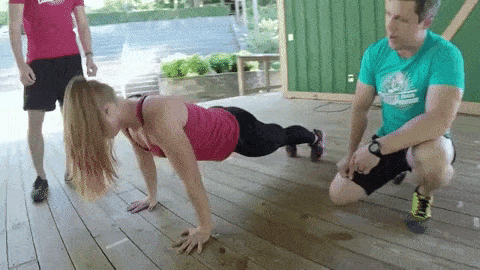


- DIPS:

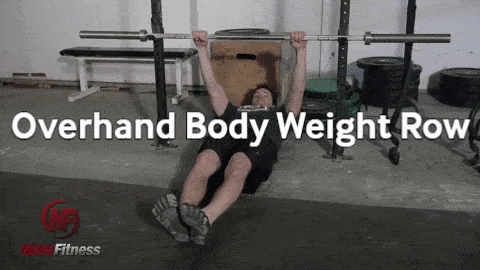
Get as strong as possible with these exercises while eating enough calories and protein, and you will gain the right kind of weight! It’s how I bulked up correctly:)
Here’s a sample workout to gain weight, though you can follow our 6 level gym workout routine too.
WEIGHT GAIN MONDAY WORKOUT:
- Squats (4 sets of 8 reps)
- Benchpress (3 sets of 8 reps)
- Pull-Ups (3 sets of 10 reps)
WEIGHT GAIN WEDNESDAY WORKOUT:
- Deadlift (3 sets of 5 reps)
- Overhead Press (3 sets of 8 reps)
- Inverted Rows (3 sets of 8 reps)
WEIGHT GAIN FRIDAY WORKOUT:
- Front Squats (3 sets of 5 reps)
- Dips (3 sets of 10 reps)
- Chin-Ups (3 sets of 10 reps)
Not sure what those numbers mean? Read our article on sets and reps.
How much should you lift? Read our guide on “How much weight should I lift?“
Don’t worry about isolation exercises like triceps extensions, shoulder shrugs, bicep curls or crunches.

You can certainly do them, but only AFTER you’ve done your heavy lifts for the day!
All of the compound exercises listed here use every muscle in your body, and when you overload your body with calories and protein, those muscles will grow.
- Want more workouts to follow? Read through our Strength Training 101 series that will answer all your questions!
- Terrified to even step foot into a gym? We understand! Check out our Beginner’s Guide to the Gym article for some basic strategies and workouts.
- Want somebody to tell you EXACTLY how to exercise and how to eat? Check out our 1-on-1 Coaching Program.
Rule #7) How to Strength Train to Gain Weight
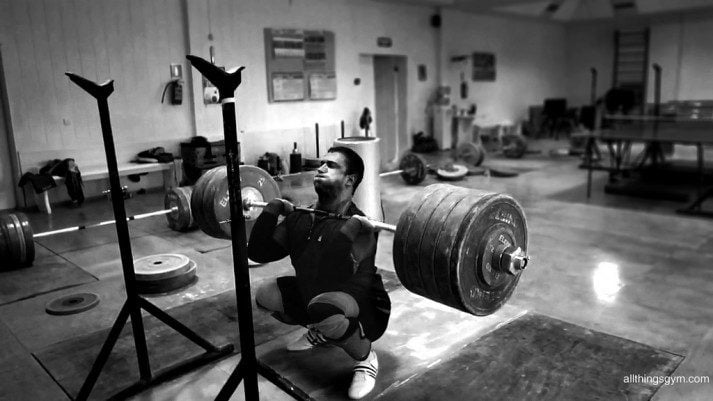
If you are going to get bigger, you need to consistently increase the difficulty with every workout.
Every time you train, your muscles break down and have to rebuild themselves.
You are teaching them to say “I must get bigger and stronger in case I have to do that again!”[16]
This is called “progressive overload,” and it’s the foundation of strength training.

So how do you progressively overload your muscles?
- Lift more weight than last time.
- Do more sets or reps than last time.
- Wait less time between sets than last time.
- Do a more difficult movement or variation.
If you did 3 sets of 5 reps of squats at 95 pounds last week, go for 3 sets of 5 reps at 100 pounds this week!
Did knee push-ups last month?
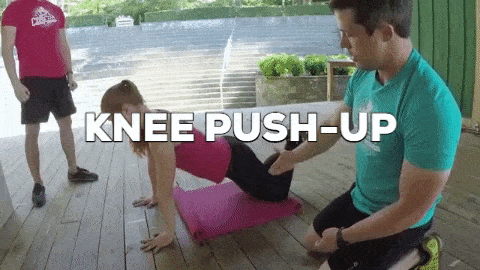
Great, try to do regular push-ups this month.
Always increase the challenge, and the best way to do that is by tracking your workouts!
Write down how you train, so that way you know exactly how to get stronger next time. I use Evernote on my phone, but you can use an old school notebook or whatever floats your boat.
Write down exactly how much you lifted, how many sets, how many reps, and how you felt.
And then next time?
Pick up more.
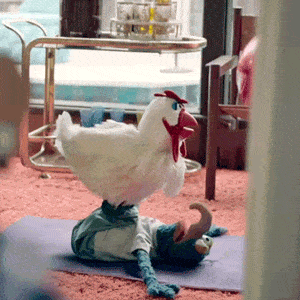
In addition to the protein shakes mentioned back in Rule #3, consider a creatine supplement – it allows your muscles to store more water – which will both help you potentially lift heavier and improve your performance in the gym!
If you don’t want to build your own workout routine, or you’re not sure how and when to scale up your workouts for the best results, let us build a routine for you!
Our coaches will build a workout program for your goals, and every day you can check your coaching app and know exactly what to do:
Rule #8) How Many Days Per Week should I Exercise to Gain Weight And Get Bigger?

Muscles are made in the kitchen and while sleeping, NOT in the gym.
When you train, you are essentially ripping apart and breaking down your muscles.
Then, during the next 48 hours, as you are eating a caloric surplus and recovering, your muscles get rebuilt bigger and stronger.

For this reason, never exercise the same muscle before it’s ready.
In other words, try not to exercise the same muscle on two consecutive days.
Here are the best common practices for weight gain: Do a gym workout 3-4 days a week with a day off in between each (while consuming plenty of calories). This is plenty of training to promote muscle growth and weight gain.
Long story short: pick up a heavy weight in the gym 3-4 days a week for an hour.
Go HARD, go HEAVY.
And then come home, eat, and rest. If you are interested in doing some active recovery on your off days, that’s fine too.
Skinny people usually don’t need to train more, they need to eat and rest more!
Rule #9) How Much SLeep SHould I get To Get Bigger?

You should get at least 6 hours of sleep to function as a human, but getting 7-8 hours of sleep will help aid in building more muscle.[17]
This study[18] also found:
“Inadequate sleep impairs maximal muscle strength in compound movements when performed without specific interventions designed to increase motivation.”
Think of it this way:
Building muscle is hard work, your body can use all the help (and calories) it can get. Your body is doing nothing but lying there and building muscle while you’re sleeping. [19]
If you are only getting 6 hours or less, you’re not going to get all the benefits of your exercising and diet, and not giving yourself the best chance to gain weight and grow bigger.
So don’t make these sleep mistakes!
We often spend quite a bit of time with our coaching clients working with them on their sleep and environmental habits! From turning off the TV an hour earlier to even becoming a morning person, we build fun missions and challenges for our clients around stuff like this to get them results.
Rule #10: Should You Do Cardio While Trying to Gain Weight?

Depending on how you currently feel about running, this next sentence will either make you happy or miserable:
“Running might work against your efforts to gain weight and build muscle.”
When you run, your body uses up some of your excess consumed calories to fuel your runs. That makes sense.
This leaves fewer calories left over to build muscle.
Now, nobody will refute the benefits of improved cardiovascular health, nor would I EVER tell you to not do an exercise that you find fun.
In addition, a 2016 study[20] showed that doing endurance training AND strength training actually created larger muscle hypertrophy in untrained subjects than just resistance training alone.
What this means: you do you, boo.

If you’re somebody that runs and enjoys it, great!
If you’re trying to get bigger, here’s what I would recommend:
- Find a way to increase your food intake, and still know that you might be building muscle slightly slower than if you ONLY did strength training.
- Cut back on running until you reach your goal weight/size, and then introduce it back into your routine.
Is your SOLE focus on getting bigger? Do 3 things:
- Eat (a lot).
- Lift (heavier).
- Sleep (a lot).
Interested in giving your heart a workout without steady cardio?:
- Do higher volume strength workouts. Sets of 20 barbell squats is QUITE the cardio workout.
- If you’re going to run, do quick sprints or run up a hill.
- Go for walks. Yes, you can actually walk to Mordor.
Want to incorporate cardio the RIGHT way into your life, along with strength training, to start gaining weight?
Our coaching program builds custom programs to help people just like you reach your goals.
Rule #11: Realize you will put on some fat, and that’s okay.

With all of this eating, you will probably put on some fat along with your muscle.
That’s okay!

You might even be skinny enough that a bit of extra “cushion” on you is a good thing!
If you are trying to put on MOSTLY muscle and minimal fat gain:
- Target at least 1.5g of protein per pound of bodyweight (3.3g per kg).
- Eat a caloric surplus that is 250cal over your current TDEE.
And then fine tune it from there: essentially, you’re trying to thread the needle of “only build muscle, don’t add fat” which is fairly advanced and challenging.
As this 2017 study points out[21], “Protein overfeeding or the consumption of a high protein diet may not result in a gain in body weight or fat mass despite consuming calories that exceed one’s normal or habitual intake.”
This is incredibly challenging, and you do run the risk of not eating enough to build muscle. In addition, you might build less muscle than had you consumed a larger surplus of calories.
Now, what if you’re “skinny fat?”
What if you have a gut/belly, and thin arms?
IF YOU ARE “SKINNY FAT”:
- A slight caloric deficit: 200 calories under your TDEE.
- LOTS of protein: 1.5g per pound of bodyweight (3.3g per kg).
- Heavy strength training: focus on lifting REALLY heavy weights.
- Build muscle AND burn fat at the same time.
Then, once you get to a low enough body fat percentage that you can see some abdominal muscle definition, you can get back to bulking up.
Rule 12: SuperCharge Your Weight Gain Results (Build the Habit)

These are the 11 rules I’ve followed multiple times in my life whenever I have decided to gain weight.
There’s a 12th rule I want to share with you too:
Build the habit of eating and exercise:
- Put your workouts in your calendar.
- Recruit a workout buddy,
- Learn how to batch cook meals.
- Prepare large quantities of healthy food.
It’s important to build a system that sets you up for weight gain success.
It comes down to two things:
- Don’t miss workouts.
- Don’t miss meals.
So do whatever you need to do to make those things happen!
Here’s my final piece of advice: If you want permanent success, stop thinking in terms of “How fast can I gain weight?” and instead think:
“What can I do today that feels sustainable enough that I can stick with it for a year?”
This is how I get results, and how you can use the tools and tips in this article to get results too. Build small habits that become permanent parts of your life, and the results you’ll get will be permanent too.
Now, if you’re somebody that wants even MORE guidance, and specific instructions to follow, I got you:
1) Our 1-on-1 online coaching program, work with a member of Team Nerd Fitness that gets to know you and your situation. We’ll provide expert guidance and accountability, a custom workout, and regular ongoing support:
2) Join the Nerd Fitness Academy: Our self-paced online course. 1 payment, lifetime access. 20+ workouts, a character creation system, boss battles, and one of the most supportive communities in the Galaxy:
3) Join our free email list, the Nerd Fitness Rebellion! Join a few hundred thousand rebels just like you and I’ll send you a bunch of free guides too. I’m nice like that.
- The Nerd Fitness "Get Bigger" Shopping List
- Bulk like the Hulk with our rules for getting bigger
To recap our full article, here are the “12 Rules To Gain Weight Quickly”:
- Eat more food to create a caloric surplus
- Eat mostly high quality, high-calorie food.
- Eat enough protein to promote muscle growth.
- Eat enough carbs and fats to reach your goals.
- Track your progress to make sure you are getting results
- Strength training is the key to the RIGHT weight gain
- Get stronger to gain weight.
- Strength train 3 days per week with plenty of recovery.
- Get at least 7-8+ hours of sleep for optimal growth.
- Decide if cardio belongs in your workout routine.
- Learn how to build muscle with minimal fat gain.
- Build the habit of training and eating.
If you have more questions, please leave them in the comments below and I’ll gladly answer them when I get a chance!
You can do this.
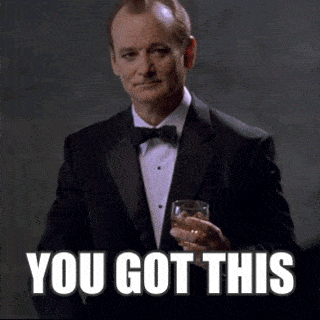
Go eat something.
Learn how to do squats and deadlifts.
Do lots of push-ups and pull-ups.
And then eat some more.
-Steve
PS: If you want to read more about this stuff, make sure you check out the following in-depth resources too:
- Ultimate skinny guide’s guide to bulking up.
- How to build muscle: best exercises and tactics.
- How fast can I build muscle?
- 9 mistakes skinny people make getting bigger.
- 6 gym workouts to follow for beginners.
###
photo credit: steak, LEGO Grocery store, lego bread and carbs, pencil, Gregor: Dmitry Klokov 250kg Front Squat Wallpaper – All Things Gym, W_Minshull Hardcore Stormies Hit The Gym, Speed
Click Here Neurofeedback Brain Injury Greenville
from Greenville Brain Training https://ift.tt/2tZ7BGh
via IFTTT


Comments
Post a Comment